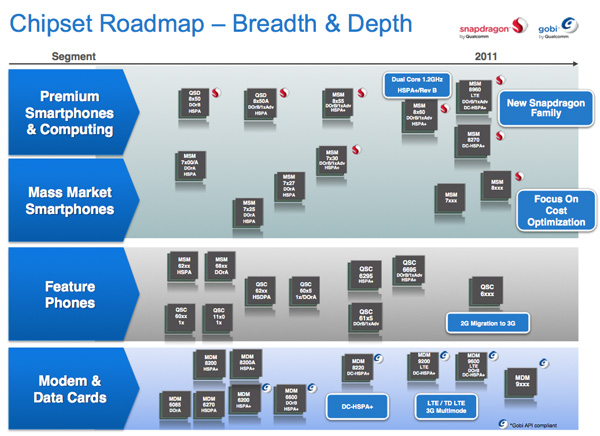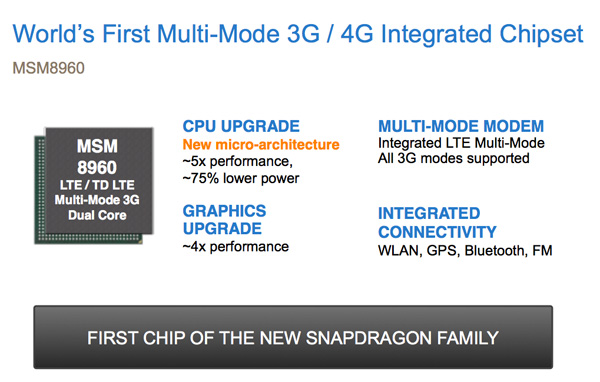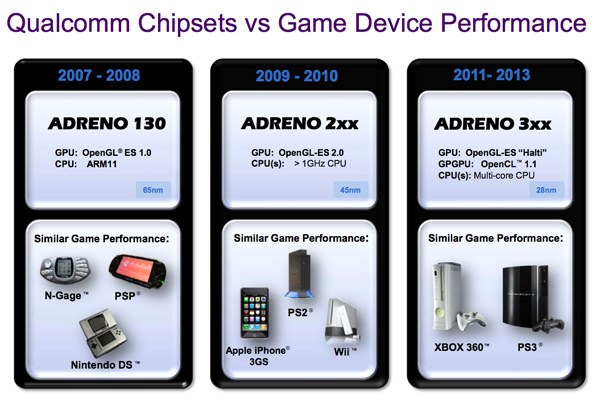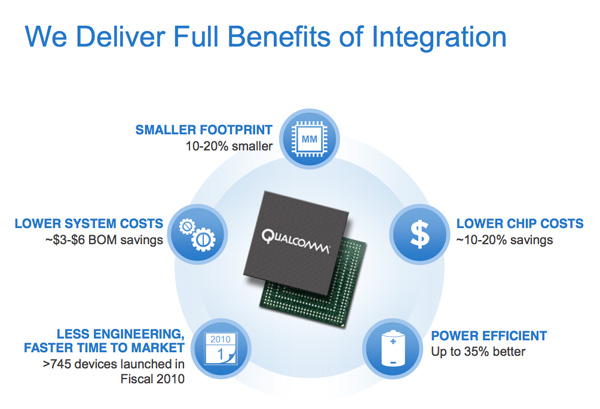Qualcomm Reveals Next-Gen Snapdragon MSM8960: 28nm, dual-core, 5x Performance Improvement
by Anand Lal Shimpi on November 17, 2010 11:00 PM EST- Posted in
- Smartphones
- Snapdragon
- Qualcomm
- MSM8960
- Adreno
- Mobile
- SoCs
Earlier today Qualcomm briefed analysts on its Snapdragon SoC roadmap. The current Snapdragon is available in both 65nm and 45nm versions integrating a single Scorpion CPU core running at up to 1GHz and an Adreno 200 or 205 GPU (respectively). Snapdragon was the SoC of choice for many Android phones over the past year and a half, not to mention the only SoC available in Windows Phone 7 devices.
In the coming months we’ll see the first dual-core Cortex A9 based NVIDIA Tegra 2 SoCs ship in devices. Sometime next year we’ll see A9 based OMAP4 SoCs in smartphones as well. So what does Qualcomm have in store for us over the next few years?
First we have the MSM8260 and 8660 SoCs. These are based on Qualcomm’s current generation technologies: integrating two Scorpion cores and an Adreno 205 GPU on a single 45nm die. The 8260 features HSPA+ support, while the 8660 supports HSPA+, CDMA2000 and 1xEV-DO Rev. B. These two dual-core SoCs will run at 1.2GHz. We should see a GPU upgrade here as well.
The 8x60 SoCs started sampling over the summer and we should expect to see them in high end smartphones sometime in 2011 at the earliest.
More exciting however is what comes next. Today’s disclosures included further details for the next-generation Snapdragon SoC built on a 28nm process. The first member of the next-gen Snapdragon family is the Qualcomm MSM8960 SoC.
Inside the MSM8960 are two next-generation processor cores, presumably out-of-order as Qualcomm is promising 5x the performance of the original Snapdragon chip (2x for the move to dual cores and the rest due to OoO, larger caches and other architectural tweaks perhaps?). Qualcomm isn’t disclosing clock speed at this time.
Power consumption is said to be 75% lower, however that seems very aggressive compared to what we have today. It’s unclear if Qualcomm is talking about active or idle power, or what version of Snapdragon it is comparing to (65nm or 45nm).
On the GPU side Qualcomm is making significant performance claims as well. The MSM8960 is set to offer a ~4x improvement in graphics performance. Again, Qualcomm wasn’t specific about what the reference point was. If it’s compared to the Adreno 200, that would imply a doubling of the GPU performance we have today.
Qualcomm has separately announced that the Adreno 3xx GPU would be used in SoCs from 2011 - 2013 on a 28nm process. This appears to be the GPU family used in the next-generation Snapdragon. Even more interesting is Qualcomm stating that Adreno 3xx will have performance similar to the Xbox 360/PS3.
If that’s indeed the level of graphics performance we’ll see in the next 3 years, being able to play Xbox 360 titles on Windows Phone 8 may not be too far fetched.
The 8960 continues to be a single chip solution with integrated modem, supporting all 3G modes as well as LTE. The MSM8960 will begin sampling in 2011, meaning we likely won’t see smartphones based on it until 2012.




















48 Comments
View All Comments
Iketh - Sunday, November 21, 2010 - link
wow dude you're way off on your performance per core figurescoconutboy - Thursday, November 18, 2010 - link
What's up with the pic comparing the Adreno 130 to the Nokia N-guage[/i]? Did anyone actually buy that thing? I still remember the hilarious ad that showed a skater guy hanging out in an alley playing it with a crazy look on his face and the words "EXTREME HARDCORE!"That the nearly-nonexistent N-gauge gets real estate in any sort of press material is silly. It serves as a reference point only to the half-dozen people on the planet who were suckers enough to buy that POS.
macs - Thursday, November 18, 2010 - link
The rumor is that the upcoming Nexus S from Samsung will use a dual core cpu.Is that possible? Is Samsung Orion ready for mass production? I think that the first dual core on the market will be Qualcomm MSM8260 because they are still based on Cortex A8.
alxx - Sunday, November 21, 2010 - link
Nope omap4430 is already out and about.(not that TI has publicly released the docs yet)
1Ghz dual core A9 with 1GB ram (POP)
http://www.pandaboard.org/content/platform
http://pandaboard.org/content/resources/references
http://pandaboard.org/content/resources/omap-devic...
http://omappedia.org/wiki/PandaBoard_FAQ
US$174 if digikey has any stock
http://dkc1.digikey.com/us/en/ph/ti/pandaboard.htm...
Looks to be a nice one for a low power media center with hdmi and dvid with full HD output
Be one for you guys to get your hands on and give a run
Can run android , angstrom , maemo or ubuntu. Less over head running angstrom.
Easy way to build an image is with the online image builder they have
http://www.angstrom-distribution.org/narcissus/
T2k - Thursday, November 18, 2010 - link
...and their rumored Android-PlayStation-PSP-hybrid phone. It's coming and it's going to be huge in the mobile gaming scene.I'm not a mobile gamer - having plenty of high-ends machines at hand helps to stick with decent PC graphics ;) - but I could appreciate some decent graphics on my phone (decent != shitty iPod/iPhone-level junk graphics) too.
iwodo - Thursday, November 18, 2010 - link
How did all of a sudden Mobile GPU become so easy to make everyone seems to have their own version?Where did this Adreon came from? I know QualComm brought ATI's embedded GPU team, but did QualComm improve it themselves?
And all these sounds like Apple are going to use it for their next CPU. Since Qualcomm properly have the best CDMA / WCDMA baseband chip on the market. I dont see why not since their invented and have most of the patents in current mobile network.
Would Apple simple be using Snapdragon for their next iPhone? If so why buy Intrinsity?
Or would Apple simply be licensing the QualComm baseband part for their own SoC.
nafhan - Thursday, November 18, 2010 - link
I wouldn't say it's easy... I think there's really only three out there:-Adreno (formerly Imageon, developed by ATI before being sold)
-PowerVR SGX
-Tegra
PowerVR GPU's seem to be the most common in the mobile space.
metafor - Thursday, November 18, 2010 - link
There's also ARM's Mali, which has recently entered.These have been around for a while in one form or another. It's just never been mentioned as much before because the competition for performance wasn't as high as it is today.
jimmiwalker - Thursday, November 18, 2010 - link
I like that. I really like that. :)numberoneoppa - Thursday, November 18, 2010 - link
Shit just got real. Wow.